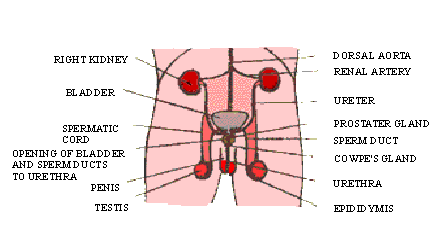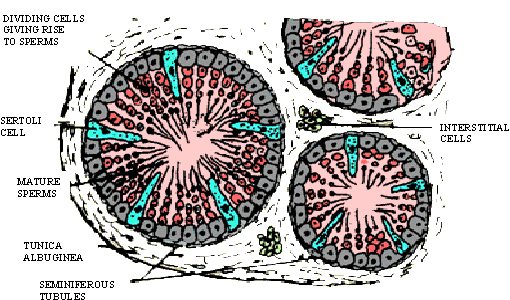|
PinkMonkey Online Study Guide-Biology
24.1 Human Reproduction
(A) Male reproductive system (Figures
24.1)
It consists of following structures:

Click here for enlargement
Figure 24.1 Male reproductive system (Position in
the body)
(1) Testes : The paired oval testes
lie outside the abdominal cavity in man, in a skin-covered special
sac called the scrotum. The main functions of the testes
are the production of sperm and the synthesis of male sex hormones.
Since temperature is an important factor in sperm production, the
position of testes within the scrotum provides a lower temperature
(at least 2-3oC lower) than within the abdominal cavity.
(2) Ducts and glands
Ducts, rete testis and epididymis.
The spermatozoa from the seminiferous tubules are transported to
the exterior by ducts. The seminiferous tubules open by number of
vasa-efferentia that join to form a network known as the rete testis.
About 20 tubes from the rete testis lead into the long (about
20 feet) coiled tube, the epididymis, located on the surface of
each testis. The epididymis stores sperm before ejaculation,
and secretes a small portion of the semen. As the epididymis emerges
from the testes, it forms the vas deferens (ductus deferens).
Each vas deferens enters the abdominal cavity through the inguinal
canal, arches over the bladder and opens into the back side of the
urethra. Since the urethra carries both urine and semen (sperm)
it is also called the ureto--genital canal.
SEMINIFEROUS
TUBULES
(1)
Sometimes the testes do not descend down into the scrotum during development
and no functional sperm are produced. This condition is to known as cryptorchidism
and results in sterility. In elephants and whales, temperature is not
a critical factor for functional sperm and the testes are permanently
located in the abdominal cavity.
(2) The human penis does not contain a bone,
though it is common in many mammals. The penis bone is called a baculum.
Each testis is covered by a connective tissue covering
(tunica albuginea), and send partitions inside, dividing it into
lobules. Each lobule contains many seminiferous tubules, lined by germinal
epithelial cells. These cells undergo the process of spermatogenesis (forming
spermatogonia, primary and secondary spermatocytes, spermatids and sertoli
or nurse cells), to produce spermatozoa. Between the seminiferous
tubules are numerous microscopic interstitial cells (Leydig
cells) which produce the male hormone, testosterone. The main
functions of testosterone are development of male secondary sex characteristics,
stimulation of protein anabolism and inhibition of anterior pituitary
secretions of gonadotropins.

Click here for enlargement
Figure 24.3 Transverse section through a Testis
[next page]
|
Table of Contents
24.0 Introduction
24.1 Human reproduction
24.2 Female reproductive cycle
24.3 Embryonic Development
Chapter 25
|